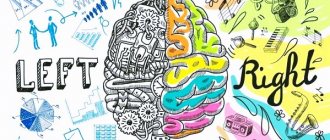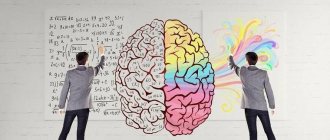The topic of intelligence is one of the most controversial and ambiguous in psychology: among scientists there is no agreement even on its general definition. What is this - a separate ability or a combination of different talents? Paul Kleinman, author of the book “Psychology. People, Concepts, Experiments,” recently published by Mann, Ivanov and Ferber, recalls the main theories, classifications and tests related to intelligence. “Theories and Practices” publishes an excerpt from the book.
For the most part, psychologists agree that intelligence is the ability to think logically and rationally, solve problems, understand social norms, traditions and values, analyze situations, learn from experience, and overcome life's challenges.
But they still can't decide whether intelligence can be accurately assessed. To solve this problem, scientists are trying to answer the following questions: - Is intelligence inherited?
— Do external factors influence intelligence?
— Does intelligence represent the presence of a number of skills and abilities?
ties or any one specific ability?
— Should IQ tests (IQ tests) be considered
development) biased?
— Is it possible to evaluate intelligence using these tests?
Today there are many theories explaining what intelligence is. Let's list some of them - the most significant.
General intelligence
Paul Kleinman, Psychology. People, concepts, experiments"
British psychologist Charles Spearman proposed a two-factor theory of intelligence, according to which two factors can be distinguished in the structure of intelligence: the g-factor, that is, the general or general ability, and the s-factor, or specific to a particular mental activity. Thus, according to the scientist, there is a certain general intelligence that determines the mental abilities of a person as a whole, or g-factor; and it can be accurately measured through a special test. Spearman found that people who scored well on one cognitive test also did well on other intelligence tests, and that those who scored poorly on one test did not do well on others. Based on this, the psychologist concluded that intelligence is a general cognitive ability that can be measured and quantified.
Intellectual abilities article on the topic
The concept of “intelligence,” which passed into modern languages from Latin in the 16th century and originally denoted the ability to understand, has become an increasingly important general scientific category in recent decades. Special literature discusses the intellectual resources of individual groups of the population and the intellectual needs of society as a whole.
It can be said without exaggeration that the vast majority of empirical research in psychology is related to the study of the cognitive sphere of personality.
As is known, the cognitive sphere of personality is studied using tests.
The concept of a “test” as a system of short standardized tasks designed to objectively measure the level of development of certain mental processes and personality traits was first introduced by the famous English psychologist F. Galton. F. Galton's ideas were further developed in the works of the American psychologist D. Cattell, who developed test systems for studying various types of sensitivity, reaction time, and short-term memory capacity.
The next step in the development of testing was the transfer of the test method from measuring the simplest sensorimotor qualities and memory to measuring higher mental functions, designated by the term “mind”, “intelligence”. This step was taken by the famous psychologist A. Binet, who in 1905, together with T. Simon, developed a system of tests to measure the level of development of children's intelligence.
Based on test methods, an indicator of mental development is obtained - the intelligence quotient (English: Intellectual quotient, abbreviated as IQ). The system of tests for determining IQ includes both tasks that require a verbal answer to posed questions, and manipulation tasks, for example, folding a whole figure from its given parts. It is required to solve (with a time limit) simple arithmetic problems and examples, answer a number of questions, and determine the meaning of certain terms and words. Answers are scored on a certain pre-established scale. The total number of points obtained for all tasks is converted into the corresponding IQ indicator.
In 1921, the journal Educational Psychology organized a discussion in which leading American psychologists took part. Each of them was asked to define intelligence and name a way in which intelligence could best be measured. Almost all scientists named testing as the best way to measure intelligence, however, their definitions of intelligence turned out to be paradoxically contradictory to each other. Intelligence was defined as “the ability for abstract thinking” (L. Theremin), “the ability to give good answers according to the criterion of truth, truth” (E. Thorndike), a body of knowledge or the ability to learn, providing the ability to adapt to the surrounding reality” (S. Colvin ) and etc.
Currently, in the theory of testology, approximately the same situation remains as in the 20s - 40s. There is still no agreement on what intelligence tests should measure); testologists still build their diagnostic systems on the basis of contradictory models of intelligence.
For example, modern American psychologist F. Freeman builds a theory according to which intelligence consists of 6 components:
- Digital capabilities.
- Lexicon.
- The ability to perceive similarities or differences between geometric shapes.
- Speech fluency.
- Reasoning ability.
- Memory.
Here, as components of intelligence, both the general mental function (memory) and those abilities that are clearly direct consequences of learning (the ability for digital operations, vocabulary) are taken.
The English psychologist G. Eysenck essentially reduces human intelligence to the speed of mental processes.
American psychologists R. Cattell and J. Horn distinguish 2 components in intelligence: “fluid” and “crystallized”. The “fluid” component of intelligence is hereditarily predetermined and manifests itself directly in all spheres of human activity, reaching its peak in early adulthood and then fading away. The “crystallized” component of intelligence is actually the sum of skills formed during one’s lifetime.
The author of one of the most famous methods for studying intelligence, American psychologist D. Wexler interprets intelligence as a general ability of an individual, which manifests itself in purposeful activity, correct reasoning and understanding, and in adapting the environment to one’s capabilities. For the famous Swiss psychologist J. Piaget, essence appears in structuring the relationship between the environment and the organism.
German scientists-teachers Melhorn G. and Melhorn H.G. intelligence is a set of abilities that characterize the level and quality of an individual’s thought processes. They believe that the function of intelligence is to mentally solve objectively existing problems. The expression of the most developed form of intelligence is directed problem thinking. It creates new knowledge for mastering the world around us. Problematic thinking leads to a more or less large and qualitative expansion of the horizons of knowledge, which makes it possible to consciously influence nature and society in accordance with human thoughts.[31].
Psychodiagnosticians have suggested that IQs derived from different tests are difficult to compare with each other because different tests are based on different concepts of intelligence and the tests include different tasks.
Currently, many psychometricians are increasingly seeing the imperfection of the intelligence assessment tools they use. Some of them are trying to improve the testing procedure, making extensive use of mathematical and static methods not only in the preparation of test systems, but also in the development of intelligence models underlying these tests. Thus, in testing, a trend has become widespread, the representatives of which use the method of factor analysis to characterize and measure intelligence.
Representatives of this direction rely on the work of Charles Spearman, who back in 1904, based on an analysis of the results of subjects passing a number of intellectual tests, put forward a theory according to which intelligence consists of a general factor “G” - “general mental energy” - involved in solving all intellectual tests, and a number of specific “S” factors, each of which operates within a given test and does not correlate with other tests.
Spearman's ideas were then developed in the works of L. Thurstone and J. Guilford.
Representatives of the factorial approach in testing proceed from the real observation that some individuals who perform well on some tests may fail to perform others. Consequently, different components of intelligence are involved in solving different tests.
Guilford experimentally identified 90 factors (abilities) of intelligence (out of 120 factors, in his opinion, theoretically possible).
In order to get an idea of the intellectual development of the subject, it is necessary, according to Guilford, to examine the degree of development of all factors that make up intelligence.
L. Thurstone, in turn, developed a model of intelligence consisting of 7 factors:
- Spatial ability.
- Speed of perception.
- Ease of handling digital material.
- Understanding words.
- Associative memory.
- Speech fluency.
- Understanding or reasoning.
In general, intellect (from the Latin intellektus - understanding, concept) - in a broad sense, all human cognitive activity, in a narrower sense - thinking. In our work we will focus on the definition of intelligence as a set of cognitive processes from sensations and perceptions to thinking and imagination, inclusive.
The leading role in the structure of intelligence is occupied by thinking, which organizes any cognitive process. This is expressed in the purposefulness and selectivity of these processes: perception manifests itself in observation, memory records phenomena that are significant in one way or another and selectively “presents” them in the process of reflection, imagination is included as a necessary link in solving a creative problem, i.e. each of the mental processes is organically included in the mental act of the subject.
Intelligence is the highest product of the brain and is the most complex form of reflection of objective reality, which arose on the basis of simpler reflections and includes these simpler (sensual) forms.
A qualitative leap in the development of human intelligence occurred with the emergence of labor activity and the advent of speech. Intellectual activity is closely related to human practice, serves it, and is tested by it. Abstracting from the individual, generalizing the typical and essential, the human intellect does not depart from reality, but more deeply and fully reveals the laws of existence.
The social nature of human activity ensures its high intellectual activity. It is aimed not only at understanding objective reality, but also at changing it in accordance with social needs. This nature of intellectual activity ensures the unity of cognition itself (thinking), the attitude towards the cognizable (emotions) and the practical implementation (will) of this action.
Raising a child’s intellect requires the comprehensive development of his cognitive abilities (the breadth and subtlety of various sensations, observation, exercises of various types of memory, stimulation of the imagination), but especially the development of thinking. Cultivating intelligence is one of the central tasks of the comprehensive harmonious development of the individual. The pedagogical encyclopedia emphasizes that “intellectual education is the most important aspect of preparing younger generations for life and work, which consists in guiding the development of intelligence and cognitive abilities by stimulating interest in intellectual activity, equipping them with knowledge, methods of obtaining it and applying it in practice, instilling a culture of intellectual work "[38]. Caring for the education of the growing intellect is the task of the family, school and pedagogical science along the entire path of their historical development.
It has been proven that intellectual development is a continuous process that takes place in learning, work, games, and life situations, and that it occurs most intensively during the active assimilation and creative application of knowledge, i.e. in acts that contain particularly valuable operations for the development of intelligence.
We can identify typical features of developed intelligence, knowledge of which is important for understanding the process of intellectual education. The first such feature is an active attitude towards the surrounding world of phenomena. The desire to go beyond the known, the activity of the mind is expressed in a constant desire to expand knowledge and creatively apply it for theoretical and practical purposes. Closely related to the activity of intellectual activity is observation, the ability to identify their essential aspects and relationships in phenomena and facts.
Developed intelligence is distinguished by its systematic nature, providing internal connections between the task and the means necessary for its most rational solution, which leads to a sequence of actions and searches.
The systematic nature of intelligence is at the same time its discipline, which ensures accuracy in work and reliability of the results obtained.
Developed intelligence is also characterized by independence, which manifests itself both in cognition and in practical activity. The independence of the intellect is inextricably linked with its creative character. If a person is accustomed to executive work and imitative actions in the school of life, then it is very difficult for him to gain independence. Independent intelligence is not limited to using other people's thoughts and opinions. He looks for new ways to study reality, notices previously unnoticed facts and gives explanations for them, and reveals new patterns.
In modern psychology it is generally accepted that learning leads to intellectual development. However, the problem of connection and interaction between a student’s learning and his intellectual development has not yet been sufficiently studied.
The very concept of intellectual (mental) development is interpreted differently by different researchers.
S.L. Rubinshtein and B.G. Ananiev were among the first to call for research into general mental development and general intelligence. Thus, Ananyev spoke about these categories as such a complex mental feature of a person, on which the success of learning and work depends.
This problem has been studied in a variety of directions. Among these studies, it is worth noting the research of N.S. Leites, who notes that general mental abilities, which primarily include the quality of the mind (although they can also significantly depend on volitional and emotional characteristics), characterize the possibility of theoretical knowledge and practical activity of a person. The most essential thing for human intelligence is that it allows one to reflect the connections and relationships of objects and phenomena in the surrounding world and thereby makes it possible to creatively transform reality. As N.S. Leites showed, some activities and self-regulation are rooted in the properties of higher nervous activity, which are essential internal conditions for the formation of general mental abilities.
Psychologists are trying to uncover the structure of general mental abilities. For example, N.D. Levitov believes that general mental abilities primarily include those qualities that are designated as intelligence (speed of mental orientation), thoughtfulness, and criticality.
N.A. Menchinskaya fruitfully studied the problem of mental development with a group of her collaborators. These studies are based on the position formed by D.N. Bogoyavlensky and N.A. Menchinskaya that mental development is associated with two categories of phenomena. Firstly, there must be an accumulation of a fund of knowledge - P.P. Blonsky drew attention to this: “An empty head does not reason: the more experience and knowledge this head has, the more capable it is of reasoning.” Thus, knowledge is a necessary condition for thinking . Secondly, to characterize mental development, those mental operations through which knowledge is acquired are important [9]. That is, a characteristic feature of mental development is the accumulation of a special fund of well-developed and firmly fixed mental techniques that can be classified as intellectual skills. In the word, mental development is characterized both by what is reflected in consciousness and, even more so, by how the reflection occurs.
This group of studies analyzes schoolchildren's mental operations from different perspectives. Levels of productive thinking are outlined, determined by the levels of analytical and synthetic activity. These levels are based on the following characteristics:
a) connections between analysis and synthesis,
b) the means by which these processes are carried out,
c) the degree of completeness of analysis and synthesis.
Along with this, mental techniques are also studied as systems of operations that are specially formed to solve problems of a certain type within one school subject or to solve a wide range of problems from different fields of knowledge (E.N. Kabanova-Meller).
The point of view of L.V. Zankov is also of interest. For him, the decisive factor in terms of mental development is the integration into a certain functional system of such methods of action that are characteristic in nature [42]. For example, younger schoolchildren were taught analytical observation in some lessons, and generalization of essential features in others. We can speak of progress in mental development when these diverse methods of mental activity are united into one system, into a single analytical and synthetic activity.
In connection with the above, the question arises about the substantive criteria (signs, indicators) of mental development. A list of these most general criteria is given by N.D. Levitov. In his opinion, mental development is characterized by the following indicators:
- independence of thinking,
- speed and strength of assimilation of educational material,
- quick mental orientation (resourcefulness) when solving non-standard problems,
- deep penetration into the essence of the phenomena being studied (the ability to distinguish the essential from the unimportant),
- criticality of mind, lack of inclination to biased, unfounded judgments.
For D.B. Elkonin, the main criterion of mental development is the presence of a correctly organized structure of educational activity (formed educational activity) with its components - statement of the task, choice of means, self-control and self-test, as well as the correct correlation of subject and symbolic plans in educational activity.
N.A. Menchinskaya considers in this regard such features of mental activity as:
- speed (or, accordingly, slowness) of assimilation;
- flexibility of the thought process (i.e. ease or, accordingly, difficulty of restructuring work, adapting to changing task conditions);
- close connection (or, accordingly, fragmentation) of visual and abstract components of thinking;
- different levels of analytical and synthetic activity.
E.N. Kabanova-Meller considers the main criterion of mental development to be the broad and active transfer of techniques of mental activity formed on one object to another object. For example, transferring the thinking pattern when deriving a formula to deriving the formula independently. A high level of mental development is associated with interdisciplinary generalization of mental techniques, which opens up the possibility of their wide transfer from one subject to another.
Of particular interest are the criteria developed by Z.I. Kalmykova in the laboratory with N.A. Menchinskaya. This is, firstly, the pace of progress - an indicator that should not be confused with the individual pace of work. Speed of work and speed of generalization are two different things. You can work slowly but generalize quickly, and vice versa. The pace of progress is determined by the number of similar exercises necessary to form a generalization.
Another criterion for the mental development of schoolchildren is the so-called “economy of thinking,” i.e., the amount of reasoning on the basis of which students identify a new pattern for themselves. At the same time, Z.I. Kalmykova proceeded from the following considerations. Students with a low level of mental development poorly use the information contained in the task conditions, often solving it on the basis of blind tests or unfounded analogies. Therefore, their path to a solution turns out to be uneconomical; it is overloaded with specific, repeated and false judgments. Such students constantly require correction and outside help. Students with a high level of mental development have a large fund of knowledge and ways of operating with it, fully extract the information contained in the conditions of the task, and constantly control their actions, so their path to solving the problem is concise, concise, and rational.
An important task of modern psychology is to build objective, scientifically based indicator psychological methods with the help of which it is possible to diagnose the level of mental development of schoolchildren at various age stages.
To date, some methods have been developed for diagnosing the intellectual development of schoolchildren during the learning process. These methods are associated with the assessment and measurement of such parameters of mental activity as:
- techniques of mental activity;
- the ability to independently acquire knowledge, etc.
Primary intellectual abilities
According to psychologist Louis Thurstone, there are seven "primary intellectual abilities" that determine a person's intelligence: verbal comprehension, verbal fluency, numerical, spatial and inductive perception, perceptual speed and associative memory.
Storytel is an international audiobook subscription service. The Storytel library contains audiobooks of almost all genres, from classics and non-fiction to lectures, stand-ups and podcasts. This is a service that solves the reading problem. It allows you to listen to audiobooks anytime, anywhere: while working out, while cooking, on the way to and from work, on the plane, before bed, and whenever else. Storytel creates and records its own unique content - lecture projects, podcasts, audio series, and also collaborates with the best voices in the country.
Concepts of intellectual development
At the moment, there are two diametrically opposed concepts of intellectual development of the individual
- Some researchers of the process of intellectual development of the individual believe that this process has an active phase of development until the age of 12–16, when a certain level of logical intelligence of the individual is reached and the person’s ability to act in the mind arises, and then the active process fades and stops. The remaining personal-psychological new formations and ways of actively relating to the world, which arise at the next stages of personality development, are auxiliary and lose their meaning at the stage of maturity.
- Psychologists belonging to another group harshly criticize the idea of an inevitable decline in the intellectual development of an individual in adulthood. They are convinced that human personal development is limitless and has no end point. It is development, including intellectual development, that is the driving force and way of existence of the individual. According to them, human development is an active process throughout a person's life.
Multiple Intelligences
According to psychologist Howard Gardner's theory of multiple intelligences, it is impossible to quantify intelligence. The scientist argued that there are eight different types of intelligence, based on relatively independent abilities and skills, and that some of these abilities can be developed in an individual better than others. Initially, he identified seven independent types of intelligence: spatial (the ability to perceive visual and spatial information), verbal (the ability to speak), logical-mathematical (the ability to logically analyze a problem, recognize relationships between objects and think logically), bodily-kinesthetic (the ability to move and exercise physical control over one's own body), musical (the ability to perceive pitch, rhythm and timbre of sound and operate with sound patterns), interpersonal (the ability to understand and interact with other people) and intrapersonal (the ability to be aware of one's own feelings, emotions and motives). Subsequently, the scientist included naturalistic intelligence in his model - the ability of a person to live in harmony with nature, explore the environment, and learn from the example of other species.
Features and concepts of development of the emotional sphere of personality
Throughout life, each person is on the path of his own development, and this development occurs in various spheres and areas.
It is difficult to imagine the process of psychological development of the individual without the process of formation and development of the emotional sphere. The formation of the emotional-volitional component is one of the most important conditions for the formation of a harmoniously developed personality. It is the emotional sphere of the individual that is the central and most important link in the overall mental development of the individual. The question of the development and formation of the emotional sphere of personality has long been a problematic issue in psychological science; moreover, there are still experts who claim that there is no single and approved concept on this topic.
Let's consider existing concepts and teachings on the topic of emotional development of the individual.
Are you an expert in this subject area? We invite you to become the author of the Directory Working Conditions
A group of psychologists, which includes P. Ekman, K. Izard, adhere to the point of view that the emotional system is present in a person from the moment of birth and thus the obvious fact is that it is one of the most mature mental systems of the individual.
Another group of researchers develops the idea that a person at birth has an absolutely pure psycho-emotional field and only in the process of growing up is this field filled with accumulated information.
In any case, all researchers agree that the development of the emotional sphere of the personality is necessary in order for it to reach its mature phase and become the source of the formation of the personality as a whole.
What is emotional development and what elements does it include?
Emotional development means:
- a person’s awareness of his feelings, on the one hand, and awareness of the experiences of another person, on the other;
- gradual differentiation of emotions and feelings into groups;
- expanding the range of objects and subjects that evoke an emotional response;
- the ability to regulate and control one’s feelings and behavioral reactions.
Finished works on a similar topic
Course work Personal development in intellectual and emotional terms 400 ₽ Abstract Personal development in intellectual and emotional terms 270 ₽ Examination Personal development in intellectual and emotional terms 220 ₽
Receive completed work or specialist advice on your educational project Find out the cost
Triarchic theory of intelligence
According to psychologist Robert Sternberg's theory of intelligence, there are three different factors of intelligence: analytical or componential (the ability to solve problems), creative or experiential (the ability to cope with new situations using past experiences and existing skills), and practical or contextual (the ability to adapt). to environmental changes).
The concept of intellectual development of personality
Definition 1
Intellectual development is the process of developing the ability to meaningfully master and practically use various types and operations of thinking. This concept also includes a person’s ability to conduct an independent analysis of events and phenomena of the surrounding reality, to draw appropriate conclusions and generalizations. An integral unit of the intellectual development of a person is also speech development, which includes mastery and free use of the vocabulary wealth of the language.
According to another definition of the concept, intellectual development is an active process of familiarizing an individual with the existing standards of the culture of society, patterns of perception of the world, ways of behavior and thinking.
The process of development of the intellectual side of personality takes place in ontogenesis from the moment of birth of a person and throughout his life.
The level of intellectual development is influenced by two factors:
- heredity, namely the level of intelligence inherited from a person’s ancestors
- the social environment that surrounds a person and is the most powerful force for personal development. Here it should be noted the important role in the intellectual development of the learning process, including in the form of educational activities. It is in the process of educational activity that the formation of mental internal mental structures occurs, which are manifested in the successful implementation of various types of intellectual activity and corresponding high levels of intelligence. The pinnacle of an individual’s intellectual development is the individual’s intellectual culture.
About individualization
The normative act establishes rights to the results of intellectual activity. There are means of individualizing certain services. These include: brand name, trademark, name of the place of origin of the product, etc. They are used to personify authors and products and services. The main value is creating healthy competition among other entrepreneurs. An exclusive right is vested in the entity that registered it, and not the developer (for example, a designer). The means of intellectual activity are also protected. They act in the category of products of a citizen's mental labor.
The legal act defines the specific procedure for the creation and rules for the liquidation of separate property. The law is clear that copyright in a particular work is not linked to ownership of it.
Laws on the results of intellectual activity
Within the framework of intellectual property legislation, constant changes took place and legal norms were improved. The guarantor of the protection of the right to the results of intellectual activity is the Constitution of the Russian Federation. Article 44 states that any property of this kind is protected by law. Regarding the results of intellectual activity, they are subject to acts of international law.
In 1970, the Russian Federation joined the World Intellectual Property Organization (WIPO).
This organization was created for the process of regulating ID throughout the world. Currently it consists of 189 countries









